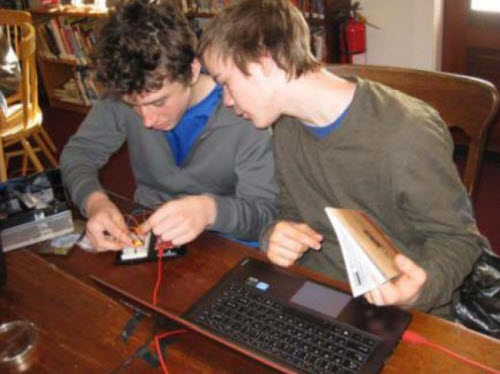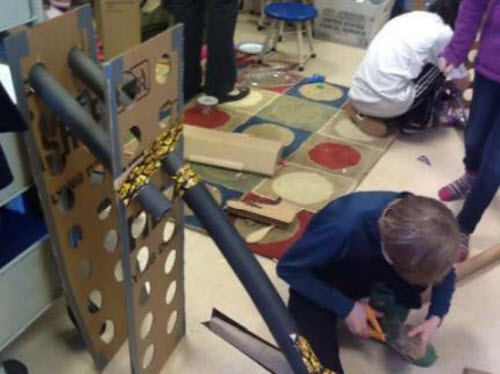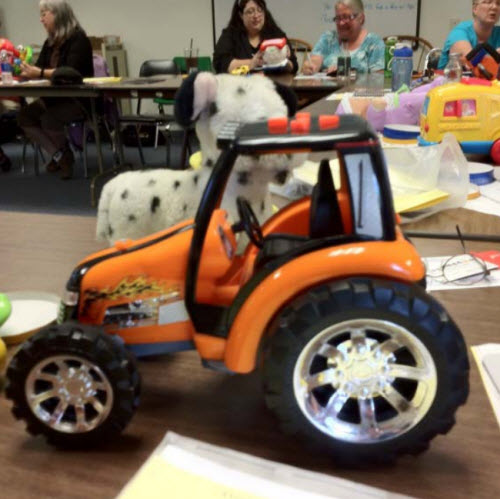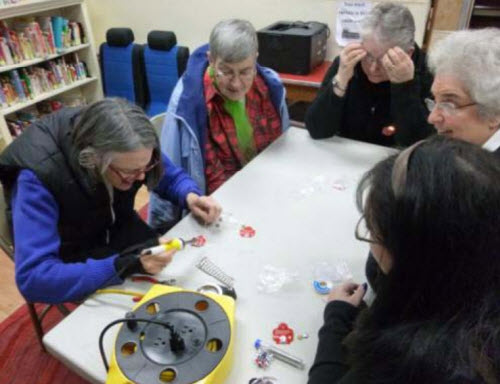Learning through Playful Exploration with Makerspaces
 Marshmallow engineering? Robotics? Punk knitting? These creative activities are all examples of recent makerspace events happening at libraries all over the country. Programs like these are all about building community and mixing traditional crafts with new technologies to explore new tools and ways of learning.
Marshmallow engineering? Robotics? Punk knitting? These creative activities are all examples of recent makerspace events happening at libraries all over the country. Programs like these are all about building community and mixing traditional crafts with new technologies to explore new tools and ways of learning.
Maker programming integrates art, science and play to help teach a wide range of techniques and skills including problem solving, collaboration and critical thinking.
Earlier this month, Sam Maskell and Mara Siegel co-presented a WebJunction webinar on makerspaces called "Making Your Space: Creators and Makers in the Library." In this resource-packed webinar, our two presenters covered the basics of what makerspaces are, and how they are relevant to libraries.
Sparking innovation
Mara, who works for the Vermont Department of Libraries as their Continuing Education Coordinator, kicked off the webinar with an introduction to the makerspace idea and gave an overview of some of the technologies that are often found in makerspaces, including coding, circuit bending and arduino. After providing a number of links to explore in these areas, Mara highlighted how maker programs can fit into the mission and vision of your library, and how you and your library can use maker programming to spark innovation and fuel creativity in your community.
 Learning through play
Learning through play
Following on Mara's overview, Sam gave some background on her experiences with makerspaces at her library – the Rockingham Free Public Library in Bellows Falls, VT, where she works as the Youth Services Librarian.
Like many other librarians, Sam has been offering what's now called maker programming since before makerspaces became hot. Back in 2010, she started with a grant-funded teen gaming series that created a local-history-based GPS scavenger hunt. It was around that time when she first read about "makerspaces." Her first thought was that it was a great – and familiar – concept: "I was already doing what they were talking about: teaching kids to code, writing programs that involved learning through playful exploration like Legos and do-it-yourself creations, and using a mix of traditional skills and adapting them in new ways. And I know that I'm not alone in this. A lot of libraries have been doing maker stuff all along."
So a year later, Sam "rebranded" what she was already doing as maker programming. "It's a great brand for marketing a type of programming and bringing people together." she said. And when she encountered some space challenges during a renovation project at her library, she got creative and sought out local partners. She teamed up with a great afterschool coordinator at a middle school in town, where they offered embedded maker labs for a couple of years.
 "It's not about the equipment, it's about the experience"
"It's not about the equipment, it's about the experience"
Sam pointed out that you don't need much to get started. As she put it, "It's not about the equipment, it's about the experience. You don't need a 3D printer or a laser cutter or woodworking machines to have a makerspace or a making program. It helps, but that's not it, so don't let that stop you. Instead, the goal – my goal, anyway – is to provide learning opportunities…experiences where all ages are allowed to creatively explore and try things, to make connections, to learn through experience, and to build community."
Toy hacking, anyone?
Much of the webinar is dedicated to sharing inspiring ideas and examples of popular programs such as toy hacking, e-sewing and circuit bending. It also lists a wide range of techniques you can use, from coding to audio/video editing tools for creating media such as book trailers and digital storytelling. Finally, it provides a number of suggestions for different spaces and partners to work with, such as local radio stations or public access TV stations.
Key takeaways for success
Other vital aspects Mara and Sam discussed are the importance of aligning your programming with your library's mission, and knowing your community's needs. With this knowledge, you can line up strategic partners, collaborators and conspirators who can help you with everything from teaching to equipment to space. Another key takeaway is to actively involve your library staff: their buy-in will be important to the success of your programs – and you'll likely find that they are a rich source of creative ideas for both program content and partnerships.
 So jump in - and fail forward!
So jump in - and fail forward!
There are also tips in the webinar to help you with planning so you can jump in and get started quickly. You don't have to know everything to get started – you can learn as you go along. Makerspaces are not just about producing perfect end results – they're also about the process, and learning from experience.
Mistakes will happen, so Sam encourages everyone to "fail forward," and get curious when things aren't working according to plan. She gently reminds us that librarians don't have to know everything. "I'm sure that those of you who work with families have told parents that they can encourage literacy in kids by modeling being a reader. And I think the same is true for learning. So when you're doing a maker program and you don't have all the answers, you have the opportunity to model being a lifelong learner – it's okay, take a breath and look it up, or see what happens ...."
Many thanks to Mara and Sam for sharing their expertise and ideas with the WebJunction community. You can review the archive page for the webinar for more resources, including slides, chat transcript, links to resources, and a complete recording of the webinar.
